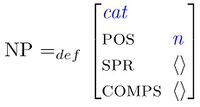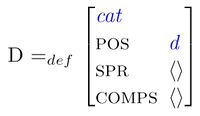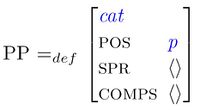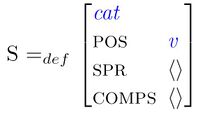Syntax 1 Wiki: Week 6
Abbreviations
To make life easier on us, we use a number of abbreviations in valence lists, e.g. NP, PP, etc. In the next exercise you are supposed to find out which feature structures each of these abbreviations stand for. To this end, do the following exercises.
- Go to the online grammar.
- Click on the lexical entry for amuse.
- Click on the tree.
- There are two NP-nodes in the verb's valence lists.
- Open both of them and find what the two feature structures have in common. That is what the symbol "NP" abbreviates.
Exercises
(1) Which feature structure does the symbol "NP" stand for?
Now follow the same procedure for the abbreviatory symbols below.
(2) Which feature structure does the symbol "D" stand for?
(3) Which feature structure does the symbol "PP" stand for?
(4) Which feature structure does the symbol "VP" stand for?
(5) Which feature structure does the symbol "S" stand for?
Auxiliaries
Through the feature AUX, we can distinguish auxiliaries from main verbs. This is necessary because in English auxiliaries have a number of syntactic properties that sets them sharply apart from main verbs.
For instance
1. Auxiliaries, but not main verbs, can appear before the negation:
- Lilly did not dance.
- *Lilly danced not.
2. Auxiliaries, but not main verbs, can appear before the subject in Yes-no questions:
- Did Lilly dance?
- Danced Lilly?
Navigation:




